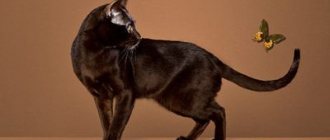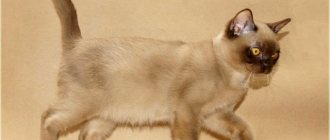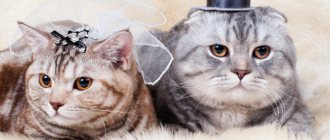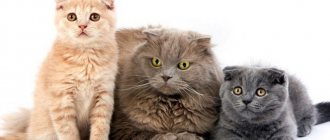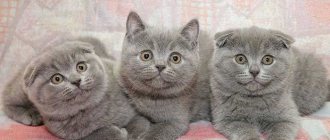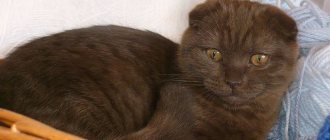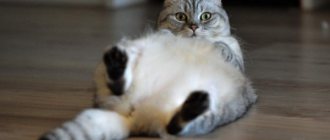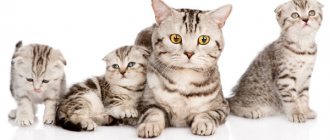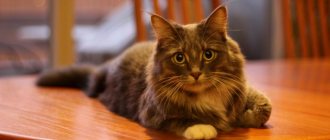Scottish cats have different colors. Scottish cats are famous because of their charming appearance and variety of colors. The color of kittens directly depends on certain genes. As a rule, these are two main shades, black and white.
Scottish Straight colors, for example, are gray with black stripes around the entire body. They are distributed as a percentage. That is, the animal’s fur is painted in two colors in different proportions. Its own gene is responsible for the dominance of one color or another.
What is ticking?
Cats with fur of this color really look very attractive and unusual. The fur coat of such pets does not have the usual stripes and at the same time it does not look monochromatic.
The ticked color of cats is also called “color without color.” In this case, the stripes are not located directly on the animal’s body, but on each individual hair. A cat with such fur looks as if covered with freckles. When such an animal moves, its fur seems to shimmer and shine. Many people believe that this coloring is very similar to the colors of squirrels or chinchillas.
What to name a Scottish kitten
Nyashki and “be-be-bears” – the charm of Scottish fold kittens is off the charts. This is the very case when you don’t have to restrain your emotions when choosing a nickname for a fold-eared cat or cat. And to make it easier for you to decide, we have compiled an extensive list of the most suitable names for Scottish cats and cats.
Now task number one. So that your kitten doesn’t think that his name is “Utibozema”, it is worth thinking about what nicknames are suitable for your purebred king of pets - Scottish Fold or Scottish Straight. Well, don’t call her Vaska. So.
List of names:
Main characteristics of color
A cat's coat can only be recognized as ticked if:
- there is no extraneous pattern at all on the animal’s body, neither clear nor blurred;
- On each hair on the animal’s fur there are several dark and light stripes (at least 3 dark stripes).
The ticked color of cats, among other things, allows for stripes on the tip of the tail and paws, the presence of a “necklace” on the neck, as well as stripes in the shape of the letter “M” on the forehead. Such drawings are not considered a reason for disqualifying cats of any breed except Abyssinian.
Features of pet care
In order for the Scottish Fold cat, whose character indicates a sweet and friendly disposition, to develop properly and grow healthy, the owner must give the animal some care.
The kitten needs all the conditions for active life, enough free space in the house. The owner must also take care of the animal’s hygiene - purchase a tray, promptly replace the filler in it, or provide the pet with free access to the street. Scotch owners should adhere to the recommendations below. Read more about how to care for and what to feed Scots here.
Types of ticked cat colors
In addition to Abyssinians, cats of the following breeds can have such coat colors today:
- Scottish and British;
- American Wirehair, Miniature, Shorthair;
- bobtail;
- American Curl;
- Persian;
- Maine Coon;
- Ceylonese;
- Devon Rex;
- munchkin and some others.
There are 9 main types of ticked colors in cats:
- black;
- cream;
- blue;
- chocolate;
- cinnamon;
- red;
- lilac;
- gold;
- faun.
Content
If you have decided to bring a white Scottish kitten into your home, you need to know everything about proper care.
- You should always ventilate the room, as tartans cannot tolerate stuffiness.
- You need to remember about bathing. It should take place at least 3-4 times a year using a special shampoo at a comfortable water temperature (up to 40 degrees Celsius). After the procedure, you need to gently blot your pet with a towel without rubbing it, use a hairdryer to dry it if the animal is not afraid of the sound of the device, and, of course, brush it. Kittens especially do not like water, so in extreme cases you can buy a special dry shampoo or choose a spray.
- Cats must be brushed at least 2 times a week. To do this, you need to use a brush with rare teeth so as not to injure your pet.
- No matter how fashionable it may be to take pets to salons, it is not recommended to cut these cats, as their fur protects them from hypothermia.
- In sedentary cats who do not leave the house at all, their claws need to be treated. You can purchase a special nail clipper and use it every two weeks. It is better to take care of buying a scratching post and get the kittens accustomed to it, observing where they like to sharpen their claws.
- Kittens' eyes can become very watery - this is due to the special structure of the nasolacrimal ducts. You should regularly wash your pet's eyes with gauze, moistening it with water.
- Ears should always be cleaned with a cotton swab soaked in vegetable oil. You can also purchase special solutions for treating ears at your veterinary pharmacy.
- Toilet. It is easy to accustom a kitten to the tray by simply placing it in the required place after sleeping and feeding. Scottish dogs quickly get accustomed to this and rarely cause trouble for their owners.
- Short-faced cats often have problems with their teeth and gums, so every week it is necessary to hygienically brush their teeth with a cat brush. You can use water or buy a special paste for pets.
Caring for a white Scot will never be a burden
From childhood, you need to pay attention to hygiene, nutrition and care of your pet. In this case, a healthy pet will always be in a great mood and will become a best friend for many years.
For more information about Scottish cats, see the following video.
Black ticked color
The coding for this color is as follows: n 25. Cats with this color have a black pattern on a copper background. The nose and eyes of animals are surrounded by a rim. The color of this edging is dark. Cats have a brick red nose and eyes that can be any color, including green. Pets with such fur do not have only blue eyes. The paw pads of black ticked animals are brown or black as standard.
Appearance
Small kittens can be easily identified by age and many parameters, primarily by the condition of the umbilical cord. If there are traces of it, we can conclude that the kitten is no more than a week old.
Small kittens have
a specific build.
Before reaching the age of one month, the body is disproportionate: with a fairly large head, miniature ears, short and weak legs. When the kitten reaches one month of age, the body and legs stretch out. The ears are just as small, the head fits into the general proportions.
By one and a half months, the color of the eyes begins to match the overall color of the coat.
In the two-month period, the body becomes elongated; in the three-month period, the ears increase in size.
Whiskers serve an important function in a cat's life, helping to navigate in space.
Starting from the age of nine, the mustache turns grey, and whiskers begin to be visible among the dark ones.
Red ticked
The coat of d 25 cats not only looks unusual due to the ticking, but is also very bright. The pattern on the body of such animals is deep red on a red background. The nose and mouth of ticked cats of this color are also surrounded by a rim of the same color.
The eyes of animals in this group can range in color from yellow to brown. The nose and paw pads are brick red.
Plain (solid)
The color of Scottish Fold cats is monochromatic and they should not have any other color. The fold-eared cat can be of the following colors: white and black, chocolate and lilac, blue and red, cream, fawn and cinnamon. The most popular color in the world among solid Scottish cats is blue. These are the majority of cats.
White
The white Scottish Straight cat can have different eyes, from blue and bright orange to rich amber and copper. Kittens of this variety remain white for the rest of their lives. If kittens have spots, then an adult cat remains white for the rest of its life.
Black
The Scottish Fold black cat is mostly bright in color. A couple of white hairs are acceptable, but if the cat has large red and brown patches, then it is not a purebred.
Black Scottish Fold cats should be bright black in color and their ears, like all fold-eared cats, should be pressed to the head, unlike straight-eared cats. A straight-eared black cat always has its ears erect.
Chocolate
The chocolate Scottish Fold looks impressive. The chocolate color is quite rare. Brown fold kittens should have a smooth, uniform coat of chocolate color. The dark brown coloring adds nobility to the cat.
A brown cat gets this color if he has chocolate, chocolate bicolor or chocolate color points in his pedigree. Chocolate Scottish kittens always delight their owners. They look very cool against a light background.
Lilac (lavender)
A lilac long-eared cat gets this color if he has either lilac color points or lilac in his pedigree. The lilac coloration goes well with orange, copper or amber colored eyes and a light brown nose. This color is also called coffee with milk.
Blue color (blue)
The Scots Blue can have a coat color of many shades of blue. Some cats may have a fur color closer to gray, and some closer to blue. Each hair must be saturated, then the coat will be perfectly blue.
Gold
This is the rarest and very beautiful color of cats with the coding ny 25. The background of the animals’ fur in this case is apricot, and the stripes on the hair are dark. The most common golden ticked color is found in British cats. According to the standard, the eyes of such pets should be emerald green. The paw pads, as well as the outline of animals in this group, are brown or black. The nose of cats of this color is brick-red.
The Scottish cat is an animal with a soft temperament and a loyal character.
Purchasing a kitten of a certain breed is an important decision, especially if the buyer is looking for a pet that will become a loving and devoted friend for many years.
When choosing a cat, it is important to take into account temperament, life expectancy, intelligence, susceptibility to hereditary diseases, difficulty of care and many other factors that indicate the characteristics of the upbringing and maintenance of a particular animal. If you are looking for an undemanding and kind pet, it could be a Scottish cat - an animal with a gentle temperament and a loyal character. Don’t think that a cat’s unique appearance and good disposition are the only advantages. As a rule, the Scottish cat breed is distinguished by its developed intelligence, rapid adaptation to various living conditions, and a high level of socialization and contact. The animal will become a real member of the family, and in addition to quality nutrition, periodic grooming and bathing, it will need daily love and affection from the owner.
Blue wool
Such cats, belonging to group a 25, have fur of a warm beige background with blue ticking. The nose and eyes of these animals are outlined with a grayish rim. The paw pads of blue cats are deep pink. The nose is the color of a withered rose. These cats have yellow eyes.
Dental changes
Just as a human child's new teeth grow gradually, a kitten's teeth do not appear at the same time.
Kittens are born without teeth, and from the second week their first milk teeth begin to erupt. At 2–4 weeks, the incisors emerge, at 3–4 weeks, the canines appear, and at 6–8 weeks, the premolars appear. Kittens do not yet have molars, that is, molars. In total, animals have 26 milk teeth, which differ in structure and color from permanent ones.
Starting from 3.5 months, the replacement of baby teeth with permanent ones occurs. The process starts with the first and second incisors. From the fourth month - premolars; from the fifth - molars. From 5.5 months, the canines on the upper and lower jaws are replaced. From the fifth month, the replacement of rudimentary fangs on both jaws begins. The process lasts up to 7 months. Like human teeth changing, the process is individual and can last up to 9 months. In males it begins earlier than in females.
So, an adult has 30 permanent teeth:
- 12 incisors are divided into sixes of the upper and lower jaws;
- 4 fangs - two on each jaw;
- 10 premolars;
- 4 molars.
Knowing and clearly distinguishing the sequence of appearance and names of teeth will help you recognize the age of a kitten by the appearance or eruption of teeth. An illustration will help you avoid getting confused about the names and locations of teeth.
When determining the age of a kitten, you should
pay attention to its behavior
. If your pet has ruined the upholstery of the furniture by chewing it, hunts for laces and chews them at night, this may be a sign of teething. When teething, there is a need to chew toys, bedding, and other objects that interest the animal.
It is indeed possible to determine the age of a baby by the appearance of teeth, but if the animal is an adult, this approach may fail. For a mature individual, the condition of the teeth will indicate age only approximately. An old cat may have both diseased and dilapidated teeth.
Changes in the dental formula after the change of primary teeth can be taken into account in a complex analysis with other indicators in determining the age of the cat.
By the age of one and a half years, the main lobes of the first incisors of the lower jaw are fully formed. According to average indications, there are data characterizing tooth abrasion, however, due to the specific characteristics and subjective indicators of the life of an adult cat, they may not coincide with the real situation. If the lobes of the first and second incisors on the lower jaw are erased, then the cat is already at least 2–2 years and 5 months old. The lobes of the first incisors on the upper and lower jaws are worn away by the age of 3 years and 5 months. If a cat has worn out the lobes of the first and second incisors of both jaws, then he is at least 4 years and 5 months old. If the lobes are present only on the canines of the upper jaw, then the age of the animal is close to 5 years and 5 months. If the surface of the incisors is oval, the cat is about 10 years old. Loss of the first and second incisors on the upper and lower jaws is typical for 12 years. Loss of all incisors is typical for people aged at least 16 years.
Secrets of genetics
Breeders consider breeding ticked cats to be a difficult task, but at the same time very exciting. At the moment, experts have been able to identify only two genes responsible for this design of the fur of furry pets: Abyssinian and common ticking.
The first gene gives the animal's hairs ticking with the same frequency of stripes. In this case, coloring with triple zoning is considered ideal. Mandatory for such an exterior is, among other things, a stripe on the back of a slightly darker shade than the body color.
The general ticking gene does not give the number of stripes on the hairs and their distribution, but simply smoothes out the saturation in the cat’s color. The homozygous form of this U gene is capable of making the pattern on the animal’s body almost invisible. In a heterozygous one, a clear pattern is observed on the paws and tail, as well as a shadow pattern on the body. This gene has the peculiarity that it begins its work from the very birth of the kitten.
Top 10 original nicknames
- Ushastik (cartoon);
- Whiskas (advertising);
- Masyanya (Internet character);
- Nafanya (cartoon “Little Brownie Kuzya”);
- Hedwig (Harry Potter's owl);
- Seal (animal);
- Teddy (teddy bear);
- Velours;
- Cloud (cloud – cloud, English);
- Bun.
Well, the name for the Scottish cat has been chosen. Congratulations! Let's move on to task number two: what to feed and love for kittens. Until the end of the cat's days. May they be long and full of celebration!
By the way, if you are familiar with the breed, then here’s how to name a British cat or a British cat, or if you want to name it based on a large list - read articles about all the names for cats.
Choosing a name
The animal's name should reflect its nature, character traits or appearance. These are usually the main criteria. It’s good if the name contains hissing sounds: this will help the animal quickly get used to its nickname. Her choice depends solely on the owner’s imagination. The name should be short and easy to pronounce: this will be more convenient for both the owners and the animal. There are a number of suitable nicknames for boys.
- You can name a cat by a traditional cat name: Fluff, Plyukha, Iris, Bow, Busik.
- Sometimes an animal is called by a human name. You can choose a noble name to match your pet: Leopold, Sylvester, Archibald.
- A purebred cat would be nicknamed Winston, Zorro, Raisin, Marquis.
There is also a choice for girls:
- based on its external features, you can give it the touching nickname Nochka, Lapka;
- the cat will remember cute words with hissing sounds: Ixi, Christy;
- The beautiful name Agrafena (Pear), Taisiya (Tasya) would be suitable.
You will learn more information about the Scottish Fold cat breed from the following video.
